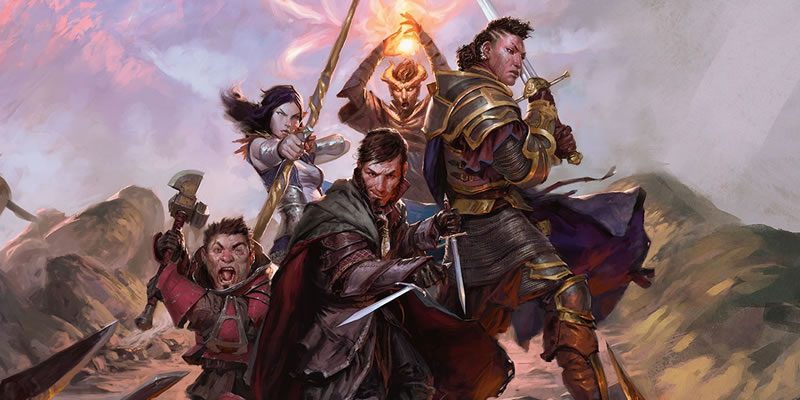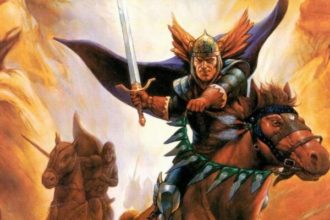The Fighter Class, Part Two

After two weeks of other topics and a weekend of GenCon, I’m back this week to continue the History of the Fighter Class. This time we’ll be talking about AD&D 1e, and as I kick off my research, I’m really wondering how much I’ll find to say about it – the rules text is quite brief. There’s also Unearthed Arcana to cover here, and it makes a considerable difference.
Part One | Part Two
Player’s Handbook
The 1e fighter doesn’t have any supporting flavor text that I can see, but that’s generally true of the book’s class writeups. They skip straight to the mechanics, and so shall I:
- d10 Hit Dice, which on release was the largest Hit Die – the barbarian won’t surpass it until Unearthed Arcana comes out. Fighters gain up to 9 HD, after which they gain 3 hit points per level.
- They can use any kind of weapons and any kind of armor.
- The whole attack progression gets hidden from the players in 1e, but the text calls out that fighters, paladins, and rangers “have the most advantageous combat table.” What it really means is, to use the later-edition parlance, +1 to hit per level.
- Fighters can use a pretty decent variety of magic items: weapons, armor, shields, potions, and a selection of everything else.
- They have good saving throws, according to the text. This is only partially true. At 1st level, fighters have the worst saving throws of any 1st-level characters, but improve more frequently than any other class. It’s not until 5th level or so that they start beating out other classes, and even then it stays close for a good while. I would call the class writeup misleading on this point.
- Fighters can establish freeholds at 9th level and attract mercenary soldiers to their cause. The PH gives the player no hard numbers except for revenue (7 sp per person in the freehold; I’d love to know how Gygax arrived at that number), so let’s look to the DMG for more details.
- The fighter gains a lieutenant who is anywhere from 5th to 7th level, with the higher-level versions also wielding more and better magic items. By comparison, the cleric gains no lieutenant, only followers.)
- The fighter gains one of four different collections of forces, with highly specific breakdowns of armaments. By comparison, the cleric gains small but random numbers of basically every type of soldier – mostly not enough to form a cohesive or effective force – and a comparable number of non-combatant followers. The fighter’s force is a little larger than a typical Roman century.
- In total, the fighter’s one advantage over the cleric is the lieutenant. The cleric’s followers are far more numerous, they pay 28% more to the church (the cleric PC) in tithes and donations than they do taxes and tariffs to the state (the fighter PC), and they arrive a whole level earlier. To contextualize that “one whole level” thing, we’re talking about the cleric needing 110K XP and the fighter needing 250K XP.
- I don’t do a lot of these kinds of head-to-head comparisons between classes, but I think it’s relevant in this case to note that this feature seems significant in the fighter class (because it’s the only fighter feature not completely shared with the paladin and ranger) and much less so in the cleric, even though it’s a more potent late-game feature for the cleric.
- A fighter can be of any race, though the level caps are ferocious for anyone but humans. Dwarves and half-orcs have the least-awful level caps, at 9 and 10 respectively, but every nonhuman race has a note that their level limit is two levels lower with 16 or lower Strength and one level lower with 17 Strength (except for gnomes, as their level limit is already so low that they only have a 17-or-lower clause, for -1 level). Halfling subraces have their own breakdown, since baseline halfling Strength is limited to 17 for men and 14 for women.
- These limits are going up when we get to Unearthed Arcana. See below.
- Only fighters can gain Exceptional Strength with a Strength score of 18. Women fighters are limited to, at most, 18/50 Strength, while men can potentially reach 18/00 Strength. In short, Strength is the best stat in the game, fighters are better at being strong than other classes, and if you start with a Strength score that isn’t 18, then I feel bad for you, son. I have no idea why this looked like a good idea when it was written, but it’s only too obvious to note that it shaped the whole culture of D&D that followed it.
- Only fighters can gain additional hit points per Hit Die above 16 Con – everyone else caps out at +2, but fighters gain +3 for 17 Con and +4 for 18 Con. (Still not as important, pound for pound, as 18/xx Strength.)
For all that that’s a lot of words, there’s just not very much there with the fighter. You can tell, because I got hip-deep in explaining ability scores. There’s not a twitch of change from the Everyman conception of the class. They hit things and soak up damage, and if they survive long enough they can subcontract their hitting-related activities to their New Friends. It is the clearest example of the Wild West meritocratic ideals that others have commented on – you spend the first eight levels as an Everyman, and suddenly achieve de facto nobility, without any clear position in a political or military hierarchy. I’m also pretty sure there’s a table specifying additional attacks per round as you progress, but I can’t find it right now, and it’s going to get revised in UA anyway.
Unearthed Arcana
Unearthed Arcana retunes some fundamental rules, like level limits, in ways that do substantially matter to the fighter class, and also offers the class a huge power boost.
- Fighters and rangers (paladins have been de-fightered and turned into their own class category, which has a whole ton of unexamined knock-on effects) can now specialize in weapons, using the newly-introduced weapon proficiency slots. This grants a +1 bonus to hit, a +2 damage bonus, and an increased number of attacks per round, varying by the weapon type. With a melee weapon, you could eventually be dishing out five attacks over every two rounds – and as we’ve talked about before, remembering if this is an odd round or an even one is a mental burden that no one needs.
- There’s also Double Specialization, which is sort of stupid on its face and carries unnecessary restrictions as to which kinds of weapons you can choose (melee only, no polearms, no two-handed sword… er, why?), just to make sure you’re so invested in one weapon that you won’t even consider picking up a weapon of any other type, no matter how magical it is.
- Bows and crossbows have further rules, introducing point-blank shots for double damage. Bows are the most expensive weapons to specialize in, but they gain an additional attack per half-round over melee weapons (that is, two attacks per round for bows at 1st-6th level, compared to three attacks every two rounds for melee.
- Also I think this is the first time I realized that Strength modifiers apply to bows in 1e?
- Within the weapon proficiency system (which is a staggering nerf to the fighter class – what happened to “yes you can use any weapon”?), fighters gain the second-largest number of slots, at 4. Only the barbarian gets more, at 6. The fighter also suffers only a -2 penalty for nonproficiency (and the barbarian -1), which… man, what a pointless kick in the teeth.
- In case I need to explain why this is so shockingly bad, not only does this take away universal proficiency, it also means that the fighter’s ability to use any magic weapon turns into only a minor penalty for using that +1 glaive-guisarme that you found but aren’t proficient in. This penalty is larger than the weapon’s bonus. Congratulations, it is functionally just not treasure for anyone in the party.
- This book also bumps up the level limits for all nonhuman races, and further grants that single-classed characters can exceed that limit by 2. It also plots level limits downward for low (that is, not-18) ability scores, and upward for higher, if you somehow find yourself with an ability score north of 18.
- I just want to say how atrocious this rule is. If you have great stats, you also get to enjoy the game for longer. If you have crummy stats, you really should nuke and pave that character so you don’t get attached to a character who will get level-limited early. Please don’t @ me with your stories about how you never played to level-limit anyway – that kind of campaign is unbalanced in favor of the nonhuman races. Questing for wishes (and it’s going to take a mess of them) to increase your ability score just so you can gain a level turns the game into a constant treadmill of needing that next wish and hoping you don’t waste a ton of XP along the way.
In the balance, UA does nothing to expand or develop the fighter’s theme. It narrows the class concept by carving off “chivalrous mounted warrior” into its own class, if and only if you have high enough ability scores to be hilariously overpowered and thus get to play the better-than-you class. I don’t like extensive negative rhetoric in discussing any game’s mechanics, but UA makes a janky game worse and lays out all the things your character can’t do.
There may well be 1e fighter options and general content scattered throughout the many, many Dragon Magazine articles, but I haven’t found them with a casual Google search and I really most sincerely don’t have time to dig through my (near-complete) collection by hand. Assuming no one comes along with issue numbers, the next article in this series will move on to 2e. I could almost stop at copying and pasting this week’s article, but the absence of UA’s most broken classes makes a huge difference in the fighter class’s relative value. (Also, of course, kits.)



